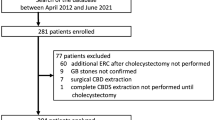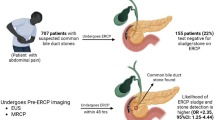Abstract
Background
Some patients with suspected common bile duct (CBD) stones are found to have sludge and no stones. Although sludge in the gallbladder is a precursor of gallbladder stones, the significance of bile duct sludge (BDS) is poorly defined. This study aimed to compare BDS with bile duct stones in terms of frequency, associated risk factors, and clinical outcome after endoscopic therapy.
Methods
The study enrolled 228 patients who underwent therapeutic endoscopic retrograde cholangiopancreatography (ERCP) for suspected choledocholithiasis. The patients were divided into two groups: patients with BDS but no stones on ERCP and patients with CBD stones. The presence of risk factors for bile duct stones (age, periampullary diverticulum, ductal dilation or angulation, previous open cholecystectomy) were assessed at ERCP. Follow-up data (36 ± 19 months) were obtained from medical records and by patient questioning.
Results
Bile duct sludge occurred in 14% (31/228) of patients and was more common in females. After endoscopic clearance, CBD stones recurred in 17% (33/197) of the patients with CBD stones, and in 16% (5/31) of the patients with BDS (p = 0.99). Common bile duct dilation was less common in the sludge group. The other known risk factors for recurrent CBD stones (age, previous open cholecystectomy, bile duct angulation, and the presence of a peripampullary diverticulum) were not statistically different between the two groups.
Conclusions
The findings indicate that the clinical significance of symptomatic BDS is similar to that of CBD stones. Bile duct sludge seems to be an early stage of choledocholithiasis.

Similar content being viewed by others
References
Carey MC, Cahalane MJ (1988) Whither biliary sludge? Gastroenterology 95: 508–523
Lee SP, Maher K, Nicholls JF (1988) Origin and fate of biliary sludge. Gastroenterology 94: 170–176
Ohara N, Schaefer J (1990) Clinical significance of biliary sludge. J Clin Gastroenterol 12: 291–294
Moskovitz M, Min TC, Gavaler JS (1986) The microscopic examination of bile in patients with biliary pain and negative imaging tests. Am J Gastroenterol 81:329–333
Grier JF, Cohen SW, Grafton WD, Gholson CF (1994) Acute suppurative cholangitis associated with choledochal sludge. Am J Gastroenterol 89: 617–619
Park HZ, Lee SP, Schy AL (1991) Ceftriaxone-associated gallbladder sludge: identification of calcium–ceftriaxone salt as a major component of gallbladder precipitate. Gastroenterology 100: 1665–1670
Lee SP, Nicholls JF, Park HZ (1992) Biliary sludge as a cause of acute pancreatitis. N Engl J Med 326: 589–593
Ros E, Navarro S, 8Bru C, Garcia-Puges A, Valderrama R (1991) Occult microlithiasis in “idiopathic” acute pancreatitis: prevention of relapses by cholecystectomy or ursodeoxycholic acid therapy. Gastroenterology 101: 1701–1709
Ko CW, Sekijima JH, Lee SP (1999) Biliary sludge. Ann Intern Med 130: 301–311
Filly RA, Allen B, Minton MJ, Bernhoft R, Way LW (1980) In vitro investigation of the origin of echoes with biliary sludge. J Clin Ultrasound 8: 193–200
Allen B, Bernhoft R, Blanckaert N, Svanvik J, Filly R, Gooding G, Way L (1981) Sludge is calcium bilirubinate associated with bile stasis. Am J Surg 141: 51–56
Lee SP, Hayashi A, Kim YS (1994) Biliary sludge: curiosity or culprit? (editorial) Hepatology 20: 523–525
Lee SP, Nicholls JF (1986) Nature and composition of biliary sludge. Gastroenterology 90: 677–686
Johnston DE, Kaplan MM (1993) Pathogenesis and treatment of gallstones. N Engl J Med 328: 412–421
Paumgartner G, Sauerbruch T (1991) Gallbladder stones: pathogenesis. Lancet 338: 1117–1124
Lee SP (1990) Pathogenesis of biliary sludge. Hepatology 12: 200S–2005S
Warren BL (1987) Association between cholangiographic angulation of the common bile duct and choledocholithiasis. South African J Surg 25: 13–15
Kim DI, Kim MH, Lee SK, Seo DW, Choi WB, Lee SS, Park HJ, Joo YH, Yoo KS, Kim HJ, Min YI (2001) Risk factors for recurrence of primary bile duct stones after endoscopic biliary sphincterotomy. Gastrointest Endosc 54: 42–48
Sugiyama M, Atomi Y (2002) Risk factors predictive of late complications after endoscopic sphincterotomy for bile duct stones: long-term (more than 10 years) follow-up study. Am J Gastroenterol 97: 2763–2767
Saito M, Tsuyuguchi T, Yamaguchi T, Ishihara T, Saisho H (2000) Long-term outcome of endoscopic papillotomy for choledocholithiasis with cholecystolithiasis. Gastrointest Endosc 51: 540–545
Bergman JJ, van der Mey S, Rauws EA, Tijssen JG, Gouma DJ, Tytgat GN, Huibregtse K (1996) Long-term follow-up after endoscopic sphincterotomy for bile duct stones in patients younger than 60 years of age. Gastrointest Endosc 44: 643–649
Ando T, Tsuyuguchi T, Okugawa T, Saito M, Ishihara T, Yamaguchi T, Saisho H (2003) Risk factors for recurrent bile duct stones after endoscopic papillotomy. Gut 52: 116–121
Pereira-Lima JC, Jakobs R, Winter UH, Benz C, Martin WR, Adamek HE, Riemann JF (1998) Long-term results (7 to 10 years) of endoscopic sphincterotomy for choledocholithiasis: multivariate analysis of prognostic factors for the recurrence of biliary symptoms. Gastrointest Endosc 48: 457–464
Ueno N, Ozawa Y, Aizawa T (2003) Prognostic factors for recurrence of bile duct stones after endoscopic treatment by sphincter dilation. Gastrointest Endosc 58: 336–340
Tanaka M, Takahata S, Konomi H, Matsunaga H, Yokohata K, Takeda T, Utsunomiya N, Ikeda S (1998) Long-term consequence of endoscopic sphincterotomy for bile duct stones. Gastrointest Endosc 48: 465–469
Keizman D, Ish Shalom M, Konikoff FM (2006) An angulated common bile duct predisposes to recurrent symptomatic bile duct stones after endoscopic stone extraction. Surg Endosc 20:1594–1599
Lygidakis NJ (1983) Incidence and significance of primary stones of the common bile duct in choledocholithiasis. Surg Gynecol Obstet 157: 434–436
Angelico M, De Santis A, Capocaccia L (1990) Biliary sludge: a critical update. J Clin Gastroenterol 12: 656–662
Author information
Authors and Affiliations
Corresponding author
Additional information
D. Keizman and M. Ish-Shalom have equally contributed to this study
Rights and permissions
About this article
Cite this article
Keizman, D., Ish-Shalom, M. & Konikoff, F.M. The clinical significance of bile duct sludge: is it different from bile duct stones?. Surg Endosc 21, 769–773 (2007). https://doi.org/10.1007/s00464-006-9153-0
Received:
Revised:
Accepted:
Published:
Issue Date:
DOI: https://doi.org/10.1007/s00464-006-9153-0




